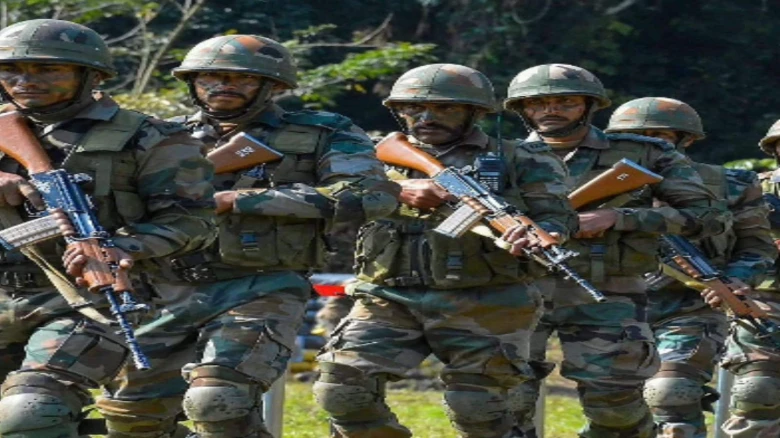National

Earlier, as part of the reorientation process, the Army's Dinjan-headquartered 2 Division had lately turned away from its CI responsibilities to devote all of its attention to the LAC. The AFSPA was repealed earlier this year in a number of the northeastern states.
mso-bidi-font-weight:bold">
mso-bidi-font-weight:bold">Digital Desk: One mountain brigade in Assam has been
given responsibility for Counter-Insurgency (CI) operations in the area while
the Army has been reorienting itself in the Northeast to focus more intently on
the Line of Actual Control (LAC).
mso-bidi-font-weight:bold">The Upper Assam districts of Tinsukia, Charaideo,
Dibrugarh, and Sivasagar, as well as the neighbouring regions, where the rebel
group ULFA still has some influence, are under the control of the brigade. Arunachal Pradesh's
Tirap, Changlang, and Longding districts, which border Upper Assam, are home to
the Naga insurgent group NSCN-K (YA) in addition to Nagaland, however, the Assam
Rifles are in charge of suppressing insurgency there. In the remaining
Northeast, where the insurgency is still present, the Ministry of Home Affairs'
paramilitary Assam Rifles conducts CI operations.
Earlier, as part of the
reorientation process, the Army's Dinjan-headquartered 2 Division had lately
turned away from its CI responsibilities to devote all of its attention to the
LAC. The AFSPA was repealed earlier this year in a number of the northeastern
states.
Senior officials stated that even though the formation is assigned
a CI function, the soldiers are constantly practicing conventional
operations.
Brigadier KS Gill, who oversees this mountain brigade, noted that
although being charged with CI tasks for this area, "we are continually
trained for the conventional duty of warfighting."
Lt. Gen. RP Kalita, commander of the Eastern Army, had previously
stated that the Army's units are always ready for conventional duty, even
when they are performing CI responsibilities.
Fighting Insurgency
Officers in Tinsukia
claimed that the Army maintains a strong ground connection with the locals and
engages with them frequently to warn them against joining insurgent groups.
This has helped to halt local recruitment to insurgent groups and has also inspired
many to desert them, according to the officers.
The brigade also engages
in a variety of activities, such as preparing gifted and disadvantaged kids for
engineering and medical entrance exams.
Earlier this year, the
Army launched a free residential coaching programme for 45 selected male
students in collaboration with Indian Oil Corporation Limited and NEIDO.
According to an Army
commander in charge of carrying out the programme, there are also plans to
begin tutoring female pupils in the near future. Additionally, a government
push on infrastructure development with the construction of several strategic
bridges providing better connectivity has also helped stem insurgency, officers
said.
The 50-year-old brigade
had previously taken part in a number of operations, such as Operations Cactus
Lily, Rhino, Pawan, and Rakshak, and had been a key component in the Mizo
insurgency's suppression.
Activist Groups Pooling
Resources for Operations
Speaking about current
insurgency patterns, top Army officials said that in the past year, evidence of
the ULFA and the NSCN-K(YA) combining forces to operate in Upper Assam and
neighbouring Arunachal Pradesh districts has surfaced as they strive to survive
and find relevance in this area.
However, the agreement,
according to Brigadier Gill, might be described as a friendship of expediency.
"Some examples of
the two financially challenged factions with different philosophies pooling
resources to operate in this region have recently come to the fore because of
dwindling cadre strength. In exchange for logistical assistance from NSCN-K
(YA), ULFA offers financial support, the official claimed.
According to a third
officer, the two insurgent organizations can function cooperatively because of
the close proximity of the two states' districts. Security forces conducted
operations last month that resulted in the deaths of one insurgent from the
ULFA and one from the NSCN-(KYA).
They said that over the
past two years, the number of ULFA cadre members has decreased due to funding
shortages, a lack of recruitments, and numerous cadre members who left the
organization despite the risk of death.
They claimed that incidents
of the insurgent organization killing and abducting Assamese residents are
corroding the support base of ULFA.
Other rebel groups, like
the NSCN-K (YA) and ULFA, also maintain camps in Myanmar, which aids in coordination;
a police officer informed the media.
Officers stated that the Army must always maintain high levels of
readiness when it comes to tacking rebels, despite the insurgents and their
supporters' declining numbers in Tinsukia.
For instance, since July of this year, 58 documented occurrences
of extortion have been reported. Three ONGC employees were abducted earlier
this year by ULFA militants from an oilfield along the border between Assam and
Nagaland.
Although the security situation in the Northeast has significantly
improved, an officer noted that insurgent groups in the area are constantly
looking for ways to demonstrate their continued relevance.
Leave A Comment